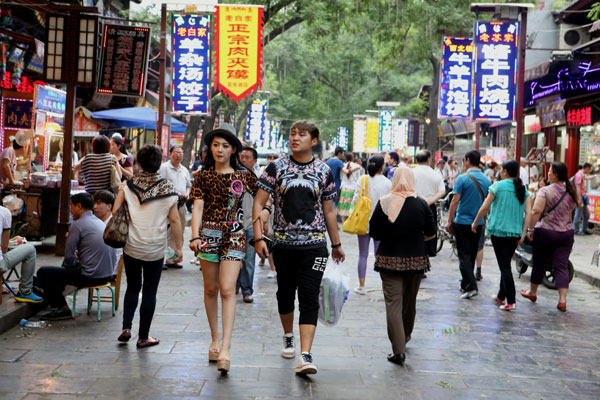

The Muslim quarter of Xi'an, featuring food stalls and sit-down restaurants, is a highlight of any Xi'an visit. (Photo: Wang Jing/China Daily)
Xi'an is hailed as the easternmost hub from which the Silk Road's land route webbed westward to reach Rome. Armies of tourists besiege the modern metropolis to view the Terracotta Warriors, but Mike Peters discovers other marching grounds worth exploring.
Few getaways from China's capital beat Xi'an. Its laid-back lifestyle and distinct culture are very different from the big cities of the east coast. It's reasonably close to Beijing, and you can see and do a lot in a short time.
Chang'an-as the city was known in its heyday-was the capital of the Tang Dynasty (AD 618-907) and has long been acclaimed as the gateway to the old Silk Road. It was the biggest city in the world when ancient Chinese culture was at its peak, and many of Xi'an's best experiences for visitors hark back to the caravan days.
Two full days can provide a good taste if that's all the time you have. The trick is to fly in early and fly out late-or take an overnight sleeper train each way. From Beijing, you can depart around 9 pm and arrive in Xi'an at 7 am with a night's rest, so you can hit the ground running.
We made our hotel reservations ahead of time, which gave us a jump on getting to the area's most popular tourist attraction: the famed Terracotta Warriors. A hotel shuttle bus met our train, swept us to our lodgings and expedited check-in for those who wanted to jump back on the bus for the one-hour trip to see the warriors' excavation and museum.
Feats of clay
The "Why?" behind one of the most exciting archaeological finds of the 20th century remains elusive. Did the emperor who unified China, Qin Shuhuang, fear the spirits of those he had conquered in the afterlife? Or did he simply expect to continue his rule once he'd crossed over to the other side? Whatever his motivation, the epic scale of this life-size army of soldiers, horses, chariots and wagons is so impressive that it's come to overshadow his other claim to fame: one of history's worst tyrants.
The facial features of each figure are unique and carefully detailed. The bright paint that once colored the clothing famously crumbled to dust when the warriors were excavated. Such challenges have sporadically delayed much of the digging still to be done as archaeologists seek new ways to preserve the old pigments.
Tour guides are available at the museum site. But our English-speaking group opted for a guidebook and the audio tour (40 yuan or $6.39).
The outside theater provides an interesting introduction to the making of the statues, but the film is long and skippable if you're pressed for time.
We started with the smallest pit (No 3), where the cheesiest souvenir on the site-a digitized photo of yourself with your face cast in stone and your garb gone warrior-is surprisingly hard to resist. We ended up at Pit No 1 for an impressive finish: 6,000-plus warriors and horses lined up and ready for battle.
The site is ironically a tribute both to intense long-term planning (ancient) and to sheer dumb luck (modern). The army was only discovered in 1974 because some farmers were digging a well and came up with an imposing clay general's head. It's said the farmers got a nice chunk of change-and relocation to new housing-and the family member most credited with the find sits in the gift shop and signs books for tourists on most days.
Archeologists find ancient decorative bead in Tibet
2015-03-12Ancient town sees dragon dance for festival
2015-03-04Adventurers try ancient cliff plank road
2015-02-15A second wind for an ancient route
2015-02-02Ancient water town makes for nice day trip
2015-01-14Copyright ©1999-2018
Chinanews.com. All rights reserved.
Reproduction in whole or in part without permission is prohibited.